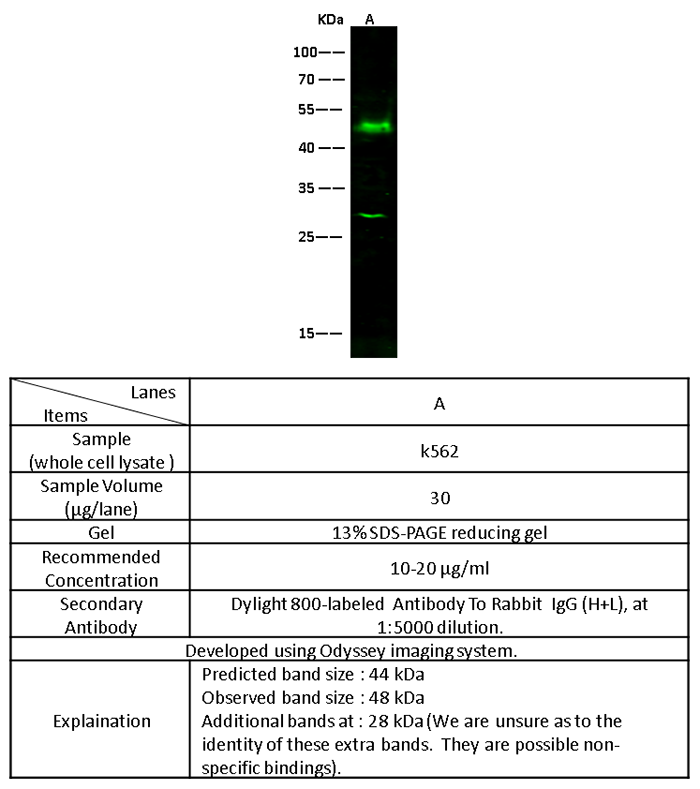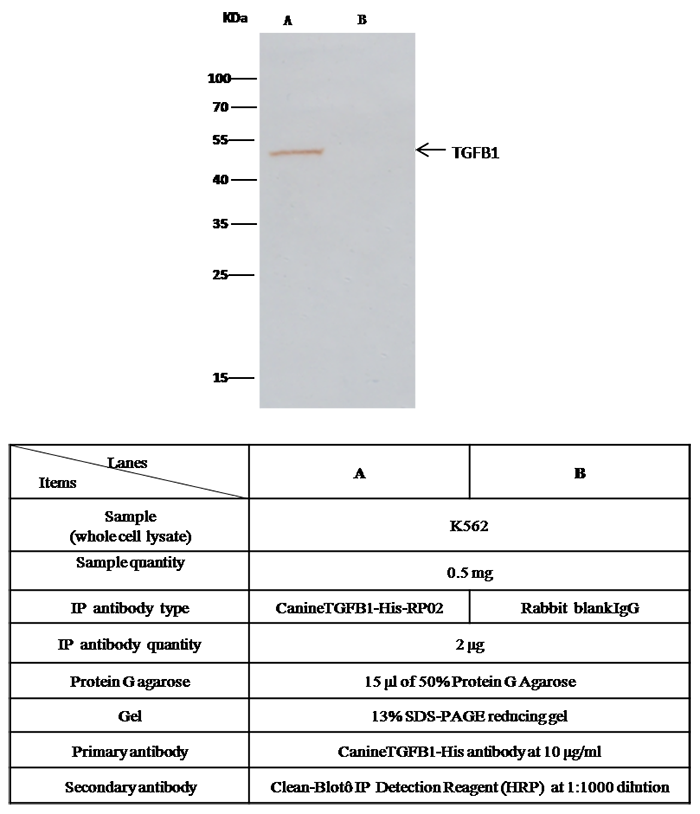-
Product Name
Anti-TGF-beta 1/TGFB1 antibody
- Documents
-
Description
Rabbit polyclonal to TGF-beta 1/TGFB1
-
Tested applications
ELISA, WB, IP
-
Species reactivity
Canine TGF-beta 1 / TGFB1
-
Alternative names
LAP antibody; CED antibody; DPD1 antibody; TGFB antibody; TGFbeta antibody; Tgfb antibody; Tgfb-1 antibody; TGFbeta1 antibody; TGF-beta1 antibody; CED antibody; DPD1 antibody; LAP antibody; Tgfb antibody; TGFB antibody; TGFB1 antibody; Tgfb1 antibody; Tgfb-1 antibody; TGFbeta antibody; TGF-beta 1 antibody; TGFbeta1 antibody
- Immunogen
-
Isotype
Rabbit IgG
-
Preparation
Produced in rabbits immunized with purified, recombinant Canine TGF-beta 1 / TGFB1 (rh TGF-beta 1 / TGFB1; ; Met1-Ser390). TGF-beta 1 / TGFB1 specific IgG was purified by Canine TGF-beta 1 / TGFB1 affinity chromatography.
-
Clonality
Polyclonal
-
Formulation
0.2 μm filtered solution in PBS
-
Storage instructions
This antibody can be stored at 2℃-8℃ for one month without detectable loss of activity. Antibody products are stable for twelve months from date of receipt when stored at -20℃ to -80℃. Preservative-Free.
Sodium azide is recommended to avoid contamination (final concentration 0.05%-0.1%). It is toxic to cells and should be disposed of properly. Avoid repeated freeze-thaw cycles. -
Applications
WB: 10-20 μg/ml
ELISA: 0.1-0.2 μg/mL
This antibody can be used at 0.1-0.2 μg/mL with the appropriate secondary reagents to detect Canine TGF-beta 1 / TGFB1. The detection limit for Canine TGF-beta 1 / TGFB1 is < 0.039 ng/well.
IP: 1-4 μg/mg of lysate
-
Validations

TGF-beta 1 / TGFB1 Antibody, Rabbit PAb, Antigen Affinity Purified, Western blot

TGF-beta 1 / TGFB1 Antibody, Rabbit PAb, Antigen Affinity Purified, Immunoprecipitation
-
Background
TGF-beta 1 is a member of the transforming growth factor beta (TGF-beta) family. The transforming growth factor-beta family of polypeptides are involved in the regulation of cellular processes, including cell division, differentiation, motility, adhesion and death. TGF-beta 1 positively and negatively regulates many other growth factors. It inhibits the secretion and activity of many other cytokines including interferon-γ, tumor necrosis factor-alpha and various interleukins. It can also decrease the expression levels of cytokine receptors. Meanwhile, TGF-beta 1 also increases the expression of certain cytokines in T cells and promotes their proliferation, particularly if the cells are immature. TGF-beta 1 also inhibits proliferation and stimulates apoptosis of B cells, and plays a role in controlling the expression of antibody, transferrin and MHC class II proteins on immature and mature B cells. As for myeloid cells, TGF-beta 1can inhibit their proliferation and prevent their production of reactive oxygen and nitrogen intermediates. However, as with other cell types, TGF-beta 1 also has the opposite effect on cells of myeloid origin. TGF-beta 1 is a multifunctional protein that controls proliferation, differentiation and other functions in many cell types. It plays an important role in bone remodeling as it is a potent stimulator of osteoblastic bone formation, causing chemotaxis, proliferation and differentiation in committed osteoblasts. Once cells lose their sensitivity to TGF-beta1-mediated growth inhibition, autocrine TGF-beta signaling can promote tumorigenesis. Elevated levels of TGF-beta1 are often observed in advanced carcinomas, and have been correlated with increased tumor invasiveness and disease progression.
-
References
- Ghadami M, et al. (2000) Genetic Mapping of the Camurati-Engelmann Disease Locus to Chromosome 19q13.1-q13.3. Am J Hum. Genet. 66(1):143-7.
- Letterio J, et al. (1998) Regulation of immune responses by TGF-beta. Annu Rev Immunol. 16:137-61.
- Vaughn SP, et al. (2000) Confirmation of the mapping of the Camurati-Englemann locus to 19q13. 2 and refinement to a 3.2-cM region. Genomics. 66(1):119-21.
- Assoian R, et al. (1983) Transforming growth factor-beta in human platelets. Identification of a major storage site, purification, and characterization. J Biol Chem. 258(11):7155-60.
Related Products / Services
Please note: All products are "FOR RESEARCH USE ONLY AND ARE NOT INTENDED FOR DIAGNOSTIC OR THERAPEUTIC USE"
